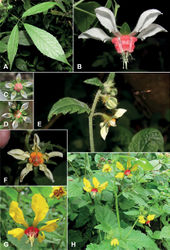Nasa humboldtiana (Urb. & Gilg) Weigend subsp. humboldtiana
| Notice: | This page is derived from the original publication listed below, whose author(s) should always be credited. Further contributors may edit and improve the content of this page and, consequently, need to be credited as well (see page history). Any assessment of factual correctness requires a careful review of the original article as well as of subsequent contributions.
If you are uncertain whether your planned contribution is correct or not, we suggest that you use the associated discussion page instead of editing the page directly. This page should be cited as follows (rationale):
Citation formats to copy and paste
BibTeX: @article{Henning2023PhytoKeys229, RIS/ Endnote: TY - JOUR Wikipedia/ Citizendium: <ref name="Henning2023PhytoKeys229">{{Citation See also the citation download page at the journal. |
Ordo: Cornales
Familia: Loasaceae
Genus: Nasa
Name
Nasa humboldtiana Henning & Acuña-Castillo & Cornejo & Gonzáles & Segovia & Wong Sato & Weigend, 2023 – Wikispecies link – Pensoft Profile
- Loasa humboldtiana Urg. & Gilg, Nova Acta Acad. Caes. Leop.-Carol. German. Nat. Cur. 76: 240, pl. 5, fig. 40 (1900). Type. Ecuador. Chimborazo: Cantón Chunchi?, in andibus ecuadorensibus, Llalla, Aug 1859, R. Spruce 6002 (lectotype, designated in Weigend 1996a[1]: 232: P! [00123885]; isolectotypes: B[destroyed, F Neg No. 10196!], BM! [BM000021453], E! [E00085319], F! [acc. #1540659], GH! [00076022], GOET!, K! [K000372786, K000372787, K000372788], M! [0113254], OXF!, P [P02273159] S! [acc. # S-R-8215], W! [0053328, 1889-0113217]).
Type
Based on Loasa humboldtiana Urb. & Gilg.
Nasa humboldtiana belongs to the Nasa triphylla (Juss.) Weigend complex (Dostert and Weigend 1999[2]), a natural group of herbaceous annuals found in the undergrowth of humid forest and disturbed sites in the northern Andes and Central America. This group is characterized by compound leaves (Fig. 2A), a trait that is very rare in Nasa (Acuña-Castillo et al. 2021[3]). The highest number of species in this complex is in the AHZ, only two out of 24 taxa (including subspecies) grow exclusively outside this region (Dostert and Weigend 1999[2]). Nasa (Loasa) humboldtiana has been very poorly understood since its original description, with only two known collections from the 19th century (Weigend 1996a[1]). In recent years, extensive field studies yielded several new taxa closely allied to Nasa humboldtiana. In a synopsis of the Nasa triphylla complex (Dostert and Weigend 1999[2]), N. humboldtiana was expanded to include three additional infraspecific taxa namely subsp. roseoalba (Weigend) Dostert (originally described as a distinct species, Loasa roseoalba Weigend: Weigend 1996a[1]), subsp. tricolor Dostert & Weigend and subsp. obliqua Dostert & Weigend. Later, targeted field work led to the discovery of two additional subspecies. Nasa humboldtiana subsp. subtrifoliata Weigend & T.Henning and subsp. glandulifera Weigend & T.Henning are endemic to small forest remnants in northern Peru and under imminent threat of extinction (Henning and Weigend 2009[4]).
Nasa (Loasa) humboldtiana was described in 1900 (Urban and Gilg 1900[5]), and the most recent herbarium collection by Richard Spruce dated back to Aug. 1859 from what today is the southern part of the province of Chimborazo, Ecuador (Spruce 1908[6] p. 222 & 249–250). Nasa humboldtiana subsp. humboldtiana differs most notably from the other subspecies by its remarkably different nectar scales, with a rectangular (instead of tapering) scale neck (Henning and Weigend 2009[4]). In 2021, one of us (XC) collected material clearly referable to the typical subspecies humboldtiana in a ravine within a conserved remnant of montane Andean forest in El Corazón, a private property located in the province of Chimborazo (Fig. 2A, B), ca. 30 km straight line from the type locality of this taxon, which signifies the rediscovery of the taxon after 162 years. The same population, represented by fewer than five individuals, has been observed in the field flowering at least twice (XC), most recently in August 2022.
Additional specimens examined
Ecuador. Chimborazo: Cantón Pallatanga, Reserva El Corazón, a montane Andean forest, ca. 2700 m, 2°3'S, 78°54'W, 10 Jul 2021, X. Cornejo & J. Josse 9388 (GUAY).
Taxon Treatment
- Henning, T; Acuña-Castillo, R; Cornejo, X; Gonzáles, P; Segovia, E; Wong Sato, A; Weigend, M; 2023: When the absence of evidence is not the evidence of absence: Nasa (Loasaceae) rediscoveries from Peru and Ecuador, and the contribution of community science networks PhytoKeys, 229: 1-19. doi
Images
|
Other References
- ↑ 1.0 1.1 1.2 Weigend M (1996a) Notes on Loasa (Loasaceae) I–III.Sendtnera3: 219–253.
- ↑ 2.0 2.1 2.2 Dostert N, Weigend M (1999) A synopsis of the Nasa triphylla complex (Loasaceae), including some new species and subspecies.Harvard Papers in Botany4: 439–467. https://www.jstor.org/stable/41761583
- ↑ Acuña-Castillo R, Romoleroux K, Luebert F, Henning T, Weigend M (2021) Morphological, ecological and geographical evolution of the Neotropical genus Nasa (Loasaceae subfamily Loasoideae).Botanical Journal of the Linnean Society196(4): 480–505. https://doi.org/10.1093/botlinnean/boab010
- ↑ 4.0 4.1 Henning T, Weigend M (2009) Systematics of the Nasa poissoniana group (Loasaceae) from Andean South America.Botanical Journal of the Linnean Society161(3): 278–301. https://doi.org/10.1111/j.1095-8339.2009.01006.x
- ↑ Urban I, Gilg E (1900) Monographia Loasacearum.Nova Acta Academiae Caesareae Leopoldino-Carolinae Germanicae Naturae Curiosorum76: 1–368.
- ↑ Spruce R (1908) Notes of a Botanist on the Amazon and Andes (Vol. 2).Macmillan & Co., London, 542 pp.
